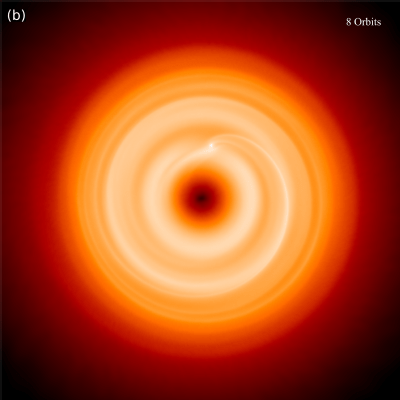Planetary system formation is a process that involves astounding and complex forces. Humans have only just started trying to understand what goes on in this extraordinarily important phase of the development of new worlds. As such, we are continuing to make new discoveries and come up with better models that better fit the observations that our instruments are able to collect.
The most recent of those improved models was announced by a research team at the University of Warwick. A paper in Astrophysical Journal Letters explores possible reasons for why there is a lack of spiral structures in newly formed protoplanetary discs. Their answer is a simple one: massive planets that form on the outside of the disc might be disrupting the spiral formation.
As with much with scientific theories recently, this one focused on computer modeling. The modeling authors Sahl Rowther and Dr. Farzana Meru performed focused on recreating the “ring and gap” features that are commonly observed in protoplanetary disks. The current theory of how this pattern forms is by young planets themselves scooping up the material in their orbital path that they then use to form themselves, creating a gap in the otherwise uniform pattern of material.
While this pattern makes sense for older systems, who actually do have planets that are able to form and scoop up the material. However, younger protoplanetary systems where most planets have not yet formed would be expected to have more of a spiral pattern. Gravity from the disc itself spinning contribute to the pattern, with the system eventually moving on to the ring and gap model once it has gravitationally stabilized after a few million years.
But astronomers have a hard time finding any protoplanetary discs in this spiral phase. The team at Warwick set out to model what might be causing the ring and gap model to occur earlier than previously suggested.
The model they found that best recreated the ring and gap system involved a large planet, about 3 times the size of Jupiter, migrating from the outer solar system to the inner. They expected there would be a torque that would push the planet in toward the star, disrupting the formation of the spiral pattern into the disc. This motion could mirror the beginning stages of the Grand Tack hypothesis, where Jupiter moved significantly closer to the sun in its early formation, causing havoc in the inner solar system, such pushing Venus into a greenhouse effect.
Credit: University of Warwick / Rowther & Meru
As with all good theories, there are some testable parts of this one. The authors note that a new generation of planetary hunting telescopes could potentially see these massive planets as they migrate their way into the inner part of the protoplanetary disk. Until we get to the point where that observation is possible, planetary formation modelers might have another confounding factor to add to their already complex gravitational equations.
Learn More:
University of Warwick – Rapid-forming giants could disrupt spiral protoplanetary discs
University of Cambridge – The spiraling signatures of planet formation
Rowther et all – Are Gravitationally Unstable Protoplanetary Discs Rare?
UT – Astronomers See a Newly Forming Planetary Disk That’s Continuing to Feed On Material from its Nebula
Lead Image Credit: Image of a model protoplanetary disc with a planet disrupting the formation of the expected spiral form. Credit: University of Warwick

